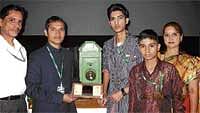'Magic Lantern' revives cinema's past

‘Shamgbarik Kharolika’ or the ‘Magic Lantern’, as the contraption is called, brought alive cinema as it were in the late 19th century right here at the 40th International Film Festival of India (IFFI), as slide after colour slide handpainted on glass told the story of Lord Krishna’s childhood. With live music and narration, the Magic Lantern was a popular medium of entertainment in Maharashtra from 1885 to 1918, when it died a slow death as silent cinema slowly gained popularity.
But family members of Mahadeo Gopal Patwardhan, who had developed the instrument with his friend Madanrao Madhavrao Pitale, are keeping alive the archival tradition at Kalyan in Maharashtra, with the help of the National Film Archives of India (NFAI) in Pune. The only difference is that while in its halcyon days it was a thing of big public admiration, now it is more of a historical relic that is showcased occasionally in film institutes and festivals. Sunil Patwardhan, a bank official and grandson of Mahadeo Gopal, is striving hard to keep alive this tenuous link with India’s cinematic past. He and his family were the cynosure of all eyes as they showcased the machine and the magic created by it at the festival on Tuesday evening.
Now a property of the NFAI after the family donated it to the institution, there is only one surviving Magic Lantern now, even though in its days of bloom, three of them were used simultaneously, says NFAI director Vijay Jadhav. “We now have slides of Ramayan, Raja Harishchandra and circus scenes which we show,” says Patwardhan, whose young sons Akshay and Atharva and wife Seema assist him.
He feels the government should help initiate research on the slides, which even after over 100 years, have colours that look freshly painted. “We want help from the government in preserving this relic. Also someone should be trained to handle this, so that it does not get lost with time,” he says. It is the last link with that part of our cinematic heritage that served as the connection between theatre and cinema,” he adds.